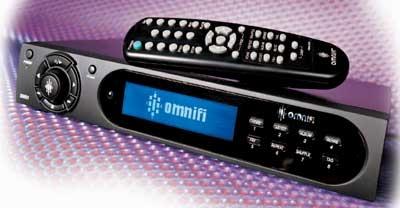Omnifi DMS1 Wi-Fi Media Receiver

Photo by Tony Cordoza
You might not be old enough to remember the good old days when people dropped needles in grooves and enjoyed the music as the records went round and round. But you're certainly familiar with taking CDs for a spin. Soon, perhaps, even that will seem quaint as more listeners trade in their physical media for streams. Just as computerization has affected most things in our lives, it's changed music storage and reproduction. And just as wireless communication is revolutionizing personal computers, it will transform music distribution as well.
Case in point: the Omnifi DMS1 Digital Media Streamer ($299). Exactly what is it? Think of it as an interface between your computer and your music playback system. More specifically, it's a box that works in conjunction with Windows-based software to transport MP3 and Windows Media Audio (WMA) files - as well as Internet radio stations using MP3 or WMA streams - from your PC to your stereo or home theater system via your home Ethernet network. And like any Ethernet-connected system, the wires can be replaced with Wi-Fi wireless transmitters and receivers. Moreover, you'll be able to send files from your home PC, also using Wi-Fi, to an optional car player, which wasn't available in time for this review (see Al Griffin's "The Wonderful World of Wi-Fi," for more about that).
The DMS1 is attractive but unassuming, with a jog wheel, cursor controls, a sprinkling of buttons, and a large dot-matrix display. The back panel has two USB ports, analog stereo audio outputs, and composite- and S-video outputs. Simple enough. But the real power lies in the DMS1's SimpleCenter software.
To get started, I installed SimpleCenter on my PC, in this case, a Toshiba Satellite notebook running Windows XP Professional. (The software runs under Windows 98SE/2000/ME/XP and requires Internet Explorer 5.0 or higher and about 100 megabytes of storage space.) SimpleCenter let me convert CDs to MP3 or WMA files, download and stream files from the Internet, access media-identification services for information on artists and albums, and organize music files and playlists. To accomplish many of its duties, SimpleCenter connects with Web sites such as Muze, Launchcast, Live365, RadioFreeVirgin, Shoutcast, and Gracenote.
Next I turned to the hardware and started by connecting the DMS1's audio and video outputs to my receiver. Then I needed to jack the DMS1 into my Ethernet home network. A USB-to-Ethernet adapter is supplied, but I wanted to connect wirelessly. My Toshiba notebook was already packing a Linksys Wi-Fi (802.11b) card and connecting to my network via a D-Link wireless router. So I attached an optional D-Link DWL-121 wireless USB adapter to the DMS1 so it could connect to the network, too, and stream files from the PC. With my components in place - notebook with Wi-Fi card, wireless router, USB-to-Wi-Fi adapter connected to the DMS1, which was, in turn, connected to my receiver - I was ready to stream.
I powered up the DMS1, which automatically searched for and found the SimpleCenter software running on my PC, and I was open for business. My first task was to rip some CDs to the notebook's hard-disk drive. The process was pretty painless - SimpleCenter works just like any other ripper I've used. I loaded a CD, chose MP3 or WMA and a bit rate, and hit the record button.
For bit rates, SimpleCenter lets you choose from 32 to 320 kilobits per second (kbps) for MP3 and 48 to 192 kbps for WMA. The ripper automatically accessed the Gracenote CDDB database and retrieved album and artist information. The files were created and automatically entered into the Media Library, which let me organize them by categories such as artist, album, genre, and so on. I could then create playlists and give them names like Hip-Hop, Opera, or My Wild Party on Saturday Night.
It took about 25 minutes to rip a 69-minute CD, which struck me as somewhat sluggish. At least you can listen to a song that's been ripped while the system is still ripping other songs on the album. I also checked out some Internet radio stations. There's a seemingly limitless number of channels out there, with every imaginable type of music - and probably some you can't imagine.
Access times to everything in my PC's Media Library were pretty fast. Music started playing about 2 or 3 seconds after I pressed the button requesting it. Most important, I could listen to everything on my home theater system, which is immeasurably better than my PC's audio system. That, of course, is the raison d'être of the Omnifi streamer.




























































